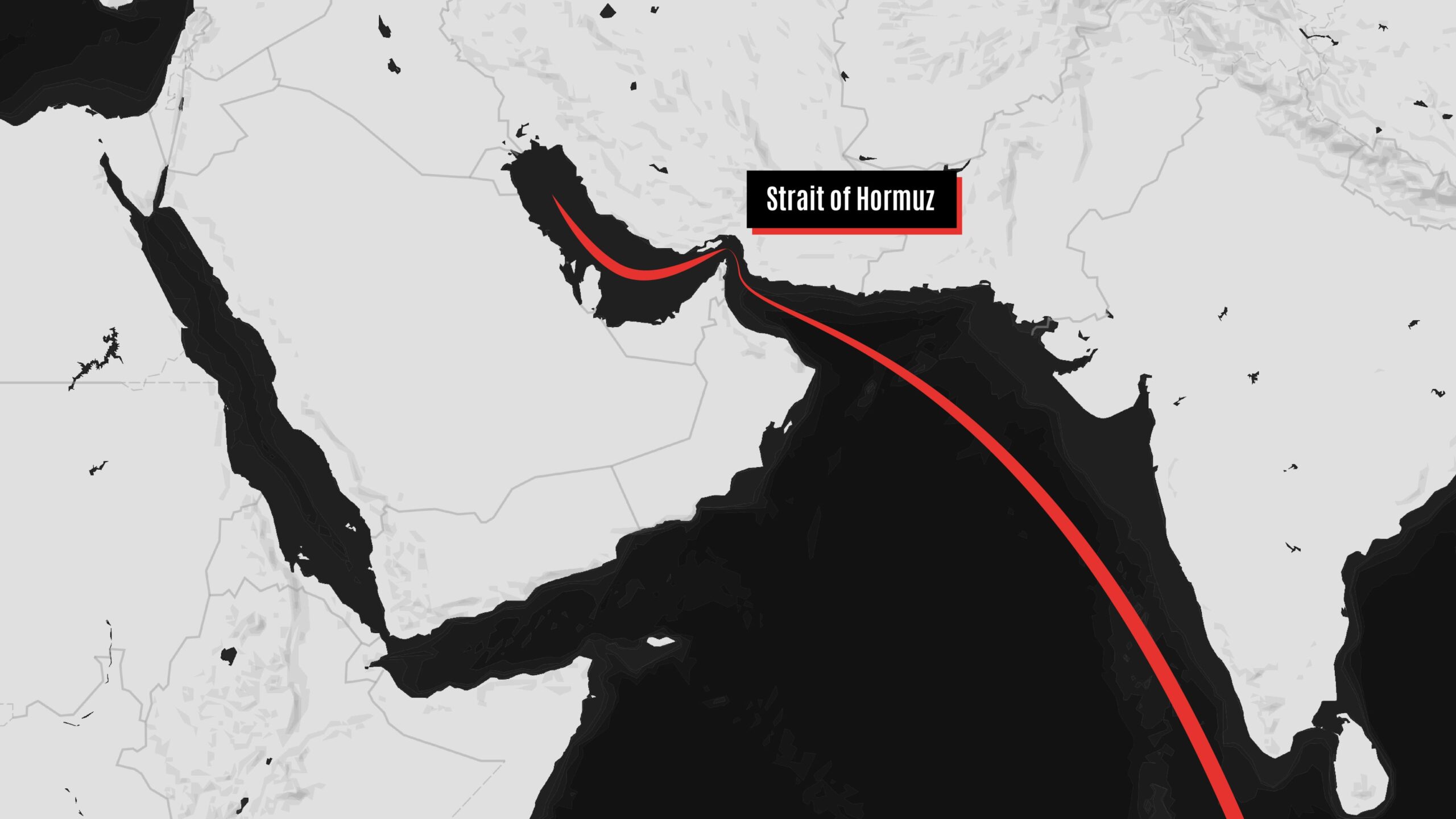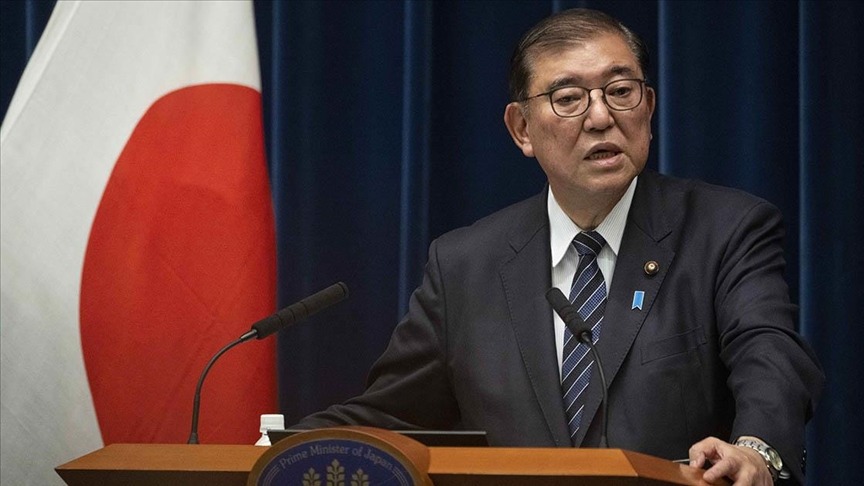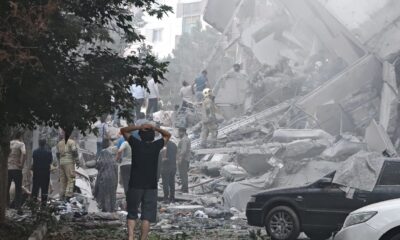Asia
Taiwan shaken by strongest earthquake since 1999, technology sector hit

A powerful undersea earthquake off Taiwan on Wednesday morning killed at least seven people, rattled the island’s vital high-tech industries and briefly triggered tsunami warnings in the Philippines and Japan’s Okinawa region.
The 7.2-magnitude quake off Hualien was the largest to hit the island since September 1999, Taiwan’s Central Meteorological Administration said. The full extent of casualties and damage was not immediately clear, but Taiwan’s interior ministry reported seven dead and hundreds injured by mid-afternoon. Photographs showed heavily toppled buildings and broken railway tracks in Hualien, where the local government suspended work and schools for a day. Roads leading into the city were also cracked.
Taiwan’s technology companies rushed to assess the impact. Taiwan Semiconductor Manufacturing Co (TSMC), the world’s largest chipmaker, evacuated some of its factories as a precaution.
In a statement, the company said: “Preventive measures have been taken according to procedure and some factories have been evacuated. All personnel are safe and evacuees have begun to return to work. The company is currently confirming the details of the impact”.
TSMC added that it had “decided to suspend work on construction sites [for new facilities] for today, and work will resume after further inspection”.
Liu Chitong, CFO of United Microelectronics, told Nikkei Asia that the world’s third-largest contract chipmaker had also evacuated its production facilities. “Some chip production machines have been stopped, and now our team is working to restart the production machines as soon as possible,” he said.
Display manufacturers Innolux and AUO also evacuated their facilities.
A manager at one of TSMC’s equipment suppliers told Nikkei Asia that his company was discussing whether to send more staff to work overtime to help chipmakers make up for the disruption during the grave-sweeping holiday later this week.
Sources at TSMC said some wafers had cracked and some machines had stopped at factories in Hsinchu. Many people are expected to have to work over the holiday as a result.
The impact in Tainan, home to some of the most advanced chip manufacturing facilities, including TSMC’s 5-nanometre and 3-nanometre factories that produce processors for Apple’s iPhones and Nvidia’s artificial intelligence computing chips, initially appeared to be milder.
On the Taiwan Stock Exchange, the Taiex Weighted Index fell immediately after the opening bell. It fell as much as 0.96 per cent during the day and closed down 0.63 per cent.
In Japan, the Meteorological Agency initially measured the magnitude of the earthquake at 7.5, then raised it to 7.7, while officials said they were investigating the difference with Taiwan’s readings. The quake was said to have struck at a depth of 23 kilometres.
Japanese authorities had initially warned of a tsunami in Okinawa that could reach up to 3 metres. At 9.18am, a tsunami of up to 30cm was recorded on the Japanese island of Yonaguni, near Taiwan. Authorities in the Philippines also issued a tsunami warning for four northern provinces.
Authorities in both countries later cancelled the warnings.
Naha airport, near the coast on the main island of Okinawa, temporarily suspended commercial flights due to the tsunami warning, but resumed operations at around 11:00.
Several Japanese companies operating in Taiwan reported minor damage, including chip manufacturing equipment maker Tokyo Electron and wafer polishing machine supplier Ebara. Tokyo Electron has several facilities in Hsinchu, Linkou, Taichung and Tainan, mostly for maintenance and corporate operations, but said it did not expect any long-term effects.
Meanwhile, a Japan Meteorological Agency official warned of further seismic instability: “Beware of earthquakes of the same magnitude for about a week after the earthquake. In particular, large earthquakes are likely to occur in the next two to three days”. According to the agency, the earthquake was most likely caused by the compression and slip of dip-slip faults.
Japanese Prime Minister Fumio Kishida offered his condolences to the victims in Taiwan. “Japan is ready to provide all necessary assistance to Taiwan, our neighbour across the sea, in its difficult time,” he said. Taiwan hit by strongest earthquake since 1999, technology sector also affected
A powerful undersea earthquake near Taiwan on Wednesday morning killed at least seven people and rattled the island’s vital high-tech industries, briefly triggering tsunami warnings in the Philippines and Japan’s Okinawa region.
The 7.2 magnitude quake off Hualien was the largest to hit the island since September 1999, according to Taiwan’s Central Meteorological Administration. The full extent of casualties and damage was not immediately clear, but Taiwan’s interior ministry reported seven dead and hundreds injured by mid-afternoon. Photographs showed heavily toppled buildings and broken railway tracks in Hualien, where the local government suspended work and schools for a day.Roads leading into the city were also cracked.
Taiwan’s technology companies rushed to assess the impact.Taiwan Semiconductor Manufacturing Co (TSMC), the world’s largest chipmaker, evacuated some of its factories as a precaution.In a statement, the company said: “Preventive measures have been taken according to procedure and some factories have been evacuated.All personnel are safe and evacuees have begun to return to work. The company is currently confirming the details of the impact”.
TSMC added that it had “decided to suspend work on construction sites [for new facilities] for today, and work will resume after further inspection”.
Liu Chitong, CFO of United Microelectronics, told Nikkei Asia that the world’s third-largest contract chipmaker had also evacuated its production facilities. “Some chip production machines have been stopped, and now our team is working to restart the production machines as soon as possible,” he said.Display manufacturers Innolux and AUO also evacuated their facilities.
A manager at one of TSMC’s equipment suppliers told Nikkei Asia that his company was discussing whether to send more staff to work overtime to help chipmakers make up for the disruption during the grave-sweeping holiday later this week.Sources at TSMC said some wafers had cracked and some machines had stopped at factories in Hsinchu. Many people are expected to have to work over the holiday as a result.The impact in Tainan, home to some of the most advanced chip manufacturing facilities, including TSMC’s 5-nanometre and 3-nanometre factories that produce processors for Apple’s iPhones and Nvidia’s artificial intelligence computing chips, initially appeared to be milder.
On the Taiwan Stock Exchange, the Taiex Weighted Index fell immediately after the opening bell. It fell as much as 0.96 per cent during the day and closed down 0.63 per cent.In Japan, the Meteorological Agency initially measured the magnitude of the earthquake at 7.5, then raised it to 7.7, while officials said they were investigating the difference with Taiwan’s readings.The quake was said to have struck at a depth of 23 kilometres.Japanese authorities had initially warned of a tsunami in Okinawa that could reach up to 3 metres.At 9.18am, a tsunami of up to 30cm was recorded on the Japanese island of Yonaguni, near Taiwan. Authorities in the Philippines also issued a tsunami warning for four northern provinces.
Authorities in both countries later cancelled the warnings.
Naha airport, near the coast on the main island of Okinawa, temporarily suspended commercial flights due to the tsunami warning, but resumed operations at around 11:00.Several Japanese companies operating in Taiwan reported minor damage, including chip manufacturing equipment maker Tokyo Electron and wafer polishing machine supplier Ebara. Tokyo Electron has several facilities in Hsinchu, Linkou, Taichung and Tainan, mostly for maintenance and corporate operations, but said it did not expect any long-term effects.Meanwhile, a Japan Meteorological Agency official warned of further seismic instability:”Beware of earthquakes of the same magnitude for about a week after the earthquake. In particular, large earthquakes are likely to occur in the next two to three days”.According to the agency, the earthquake was most likely caused by the compression and slip of dip-slip faults.
Japanese Prime Minister Fumio Kishida offered his condolences to the victims in Taiwan.”Japan is ready to provide all necessary assistance to Taiwan, our neighbour across the sea, in its difficult time,” he said.
Asia
US cries to China as Washington begins airstrikes in Iran

While the Middle East is going through one of its most tense periods, the world has been shocked by the news of a direct attack by the United States on Iran’s nuclear facilities. Washington has announced that Iran’s nuclear facilities no longer exist. At the same time, Tehran has warned in a strong tone that it will respond to this aggression.
This action was immediately met with widespread regional and international reactions. The United Nations, the European Union, global powers such as Russia and China, and America’s traditional allies in the West each took their own stance.
At an emergency meeting of the United Nations, Secretary-General Antonio Guterres described the move as a dangerous turn in an already crisis-ridden region. A wave of criticism has also emerged within the United States, with some describing the attack as successful.
At the same time, a number of lawmakers from both the Republican and Democratic parties consider Trump’s action to be without congressional authorization and unconstitutional.
Some reactions:
Russian envoy: US attack carried out without any provocation from Iran.
US Representative: The Iranian regime should not have nuclear weapons.
Iran’s ambassador to the Security Council: America once again sacrificed its security for Benjamin Netanyahu.
Israeli Ambassador to the Security Council: America changed the course of history by attacking Iran.
Rafael Grossi, the head of the International Atomic Energy Agency: Military attacks should not be carried out on nuclear facilities, saying he is ready to immediately travel to all countries regarding this case.
UK UN envoy: Military action alone cannot address concerns about Iran’s nuclear program, saying his country was not involved in Iran attack, referred to concerns about Iran’s nuclear program and said that military action alone cannot permanently address concerns about Iran’s nuclear program. He called on Iran to exercise restraint and urged the parties involved to return to the negotiating table.
France: Now is the time to end the attacks and return to negotiations.
But now why US cries to China for help to reopen Strait of Hormuz
Soon after a US airstrike in three locations, Iran closes the Strait of Hormuz, one of the world’s most important shipping routes. Now this move puts the US in trouble and US Secretary of State Marco Rubio has called on China to prevent Iran from closing the Strait of Hormuz.
However, it seems that the US is too late and according to Iran’s state-run Press TV, the decision was made by Iran’s Supreme National Security Council.
The US understands that any disruption on the supply of oil would have profound consequences for the economy and wants to play an emotional card with China to convince Iran to reopen the route as Beijing is also one of the largest buyers of Iranian oil.
It is reported that 20 percent of the world’s oil passes through the Strait of Hormuz, and major oil and gas producing countries in the Middle East use this route to export energy.
Meanwhile, US President Donald Trump has said that regime change is inevitable if the Islamic Republic cannot “make Iran great again.” His statement came following US military strikes on Iranian military facilities.
Iran: Game is not over even assuming the complete destruction of the nuclear sites
Ali Shamkhani, advisor to Ayatollah Ali Khamenei, the religious leader of Iran, has said in response to the US attacks that even assuming the complete destruction of the nuclear sites, the “game is not over”.
“Even assuming the complete destruction of the sites, the game is not over; because the enriched materials, indigenous knowledge, and political will remain intact,” he said.
He noted that “now the political and operational initiative with the right to self-defense is in the hands of the side that knows how to play smart and avoids blind shooting.”
Asia
Japan diverges from G7, urging restraint in Israel-Iran conflict

Japanese Prime Minister Shigeru Ishiba has affirmed Tokyo’s position of calling for “maximum restraint” from both Israel and Iran, despite a G7 statement earlier this week that supported Israel’s “right to self-defense.”
During a meeting of ruling and opposition party leaders on Thursday, Ishiba stated, “What the foreign minister said is the stance of the Japanese government. The G7 is the G7,” as reported by Tomoko Tamura, head of the Japanese Communist Party.
Japan, a close US ally in Asia, has long maintained friendly relations with Iran and has historically adopted a neutral approach to Middle East diplomacy, distinguishing itself from the pro-Israel stance of US administrations. Tokyo relies on the Middle East for the overwhelming majority of its crude oil imports.
G7 leaders convened in Kananaskis, Canada, and issued a statement backing Israel’s attacks on Iran. The statement affirmed Israel’s right to self-defense and condemned Iran as the “main source of regional instability and terrorism.” On June 13, when Israel’s attacks on Iran began, Japanese Foreign Minister Takeshi Iwaya declared: “The use of military force while diplomatic efforts are ongoing… is completely unacceptable and a source of deep regret. The Japanese government strongly condemns these actions.”
Iwaya added, “Japan is gravely concerned about the continuation of retaliatory attacks and strongly condemns any actions that could further escalate the situation.”
He continued, “Japan urges all parties to exercise maximum restraint and strongly calls for a de-escalation of tensions.”
During the meeting of party leaders, Tomoko Tamura, head of the Japanese Communist Party, highlighted the apparent contradiction between Iwaya’s statements and the joint G7 communiqué, suggesting the government was applying a “double standard.”
Prime Minister Ishiba responded, “What the foreign minister said is the stance of the Japanese government. The G7 is the G7.”
Meanwhile, the foreign minister announced at a press conference on Friday that a total of 87 Japanese nationals and their family members had been evacuated by land from Iran and Israel. Sixty-six individuals were evacuated from Iran to neighboring Azerbaijan, and 21 were evacuated from Israel to Jordan.
Following additional requests from Japanese citizens, a second land evacuation from Iran is scheduled for Saturday. Currently, there are approximately 220 Japanese nationals in Iran and about 1,000 in Israel.
In preparation for potential air evacuations, the government plans to dispatch two Air Self-Defense Force military transport aircraft to Djibouti in East Africa to have them on standby. With airports in Iran and Israel closed, Iwaya noted that the aircraft could be used if, for example, the airports reopen and conditions permit an airlift.
Asia
Iran-Israel war: Why US discusses regional conflict with Pakistan

US President Donald Trump and Pakistan’s Army Chief General Asim Munir held a special and important meeting during a time when tensions are rising in the Asian region. The meeting was held on Trump’s invitation and was not open to the media. However, both sides have released official statements afterward, which states that the main topics were discussed
The meeting focused on the ongoing conflict between Iran and Israel, Pakistan–India relations, especially the Kashmir issue, the situation in Afghanistan and future US–Pakistan cooperation.
Pakistan has recently improved its strategic position in the region. It has shown strong ties with China and is the only South Asian country openly supporting Iran in its conflict with Israel. Meanwhile, Pakistan remains an important player in Afghanistan.
Why the Pakistani Army Chief was invited to the US?
Although Pakistan has an elected civilian government, important decisions—especially related to foreign affairs and security—are often handled by the military. That’s why General Asim Munir was invited to meet Trump instead of the Prime Minister, General Munir’s influence has grown recently. After tensions with India, he was given the title of Field Marshal. His meeting with Trump is seen as a sign of his importance in both Pakistani and international politics.
According to the Pakistan Army’s media wing (ISPR): General Munir thanked President Trump for helping to ease recent tensions between Pakistan and India. Trump praised Pakistan’s role in fighting terrorism. Both agreed to work together in the future, especially in: Trade, Technology Minerals and energy Artificial intelligence Crypto currency and regional peace efforts as well.
President Trump also appreciated General Munir’s leadership during difficult times. Munir invited Trump to visit Pakistan, and Trump reportedly accepted the offer in principle.
Why US former peace envoy to Afghanistan, Khalilzad is not trusting Pakistan’s army chief
Former U.S. diplomat Zalmay Khalilzad criticized the meeting. He said General Munir cannot be trusted and reminded the U.S. that Pakistan has supported groups that harmed American soldiers in the past. According to Khalilzad, General Munir may be trying to get U.S. support for his interests in Afghanistan, which he believes could be risky for America.
Though no official list of US demands was made public, reports suggest a meeting was held in Saudi Arabia earlier, where American officials spoke with top Pakistani leaders. During that meeting, the U.S. reportedly made four key requests: Pakistan should help the U.S. in counterterrorism operations when needed. Pakistan should slowly reduce its relations with China. Pakistan should recognize Israel after Saudi Arabia does. If the U.S. attacks Iran, Pakistan should support the U.S. instead of staying neutral.
These demands are similar to earlier U.S.–Pakistan arrangements during the Cold War and the War on Terror.
What could be expected in the future?
This meeting could mark the beginning of a new phase in US–Pakistan relations. In the past, Pakistan helped the U.S. during the Soviet-Afghan War and after 9/11. Now, with tensions involving Iran, India, and Afghanistan—and China expanding its role—the U.S. may again be looking to Pakistan as a key partner in the region.
Time will tell whether this leads to a long-term partnership or just another temporary agreement based on short-term goals.
-

 Middle East3 days ago
Middle East3 days agoUS to launch major bombing campaign against Iran this weekend, Hersh reports
-

 Diplomacy1 week ago
Diplomacy1 week agoFormer diplomat warns forcing Iran out of the NPT is the greatest danger
-

 Middle East6 days ago
Middle East6 days agoIran targets Mossad and Unit 8200 in missile attack on Tel Aviv
-

 Diplomacy1 week ago
Diplomacy1 week agoFormer CIA analyst says Israel used ceasefire talks as a trap
-

 Middle East2 weeks ago
Middle East2 weeks agoNetanyahu’s government survives no-confidence vote as Haredi crisis is delayed
-

 Asia2 weeks ago
Asia2 weeks agoJapan, US showcase B-52 bombers in nuclear deterrence dialogue
-

 Middle East1 week ago
Middle East1 week agoIranian missile attack causes heavy damage across Israel
-

 Diplomacy1 week ago
Diplomacy1 week agoChinese academic analyzes Israel-Iran conflict for Harici: Iran holds strategic importance for China


















